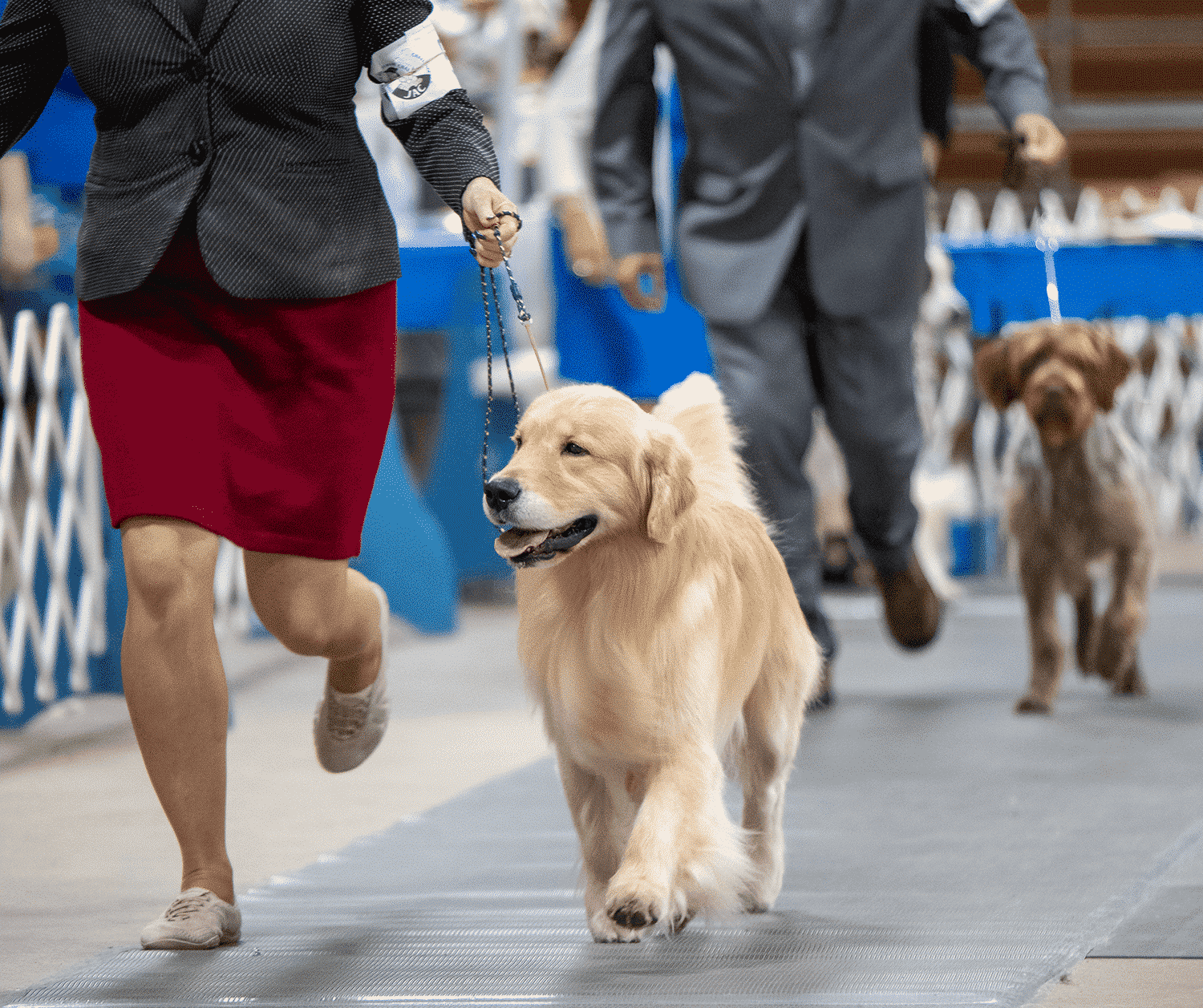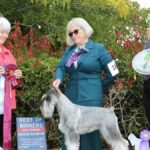Showing Dogs for Friends | It usually begins innocently enough. You’re showing your dog when you’re spotted by a member of your local all-breed club. As you exit the ring, the nice lady whose name you can’t remember approaches you with an exasperated look on her face. “Would you be able to show one of my dogs for me today,” she pleads? Apparently, she’s entered a couple of her dogs with little thought as to how she’ll get them back into the ring together should they both win their class. Since your dog just picked up its second major—and your day is done—you answer in the affirmative as the lady thrusts a lead into your hand. “We show in five minutes, ring eight,” she barks. So, you ask a friend to hold your dog when you realize that you’ve just been handed a puppy that isn’t entirely lead broken. Thankfully, it’s your lucky day and the judge puts up “your” pup for its first major. Your new friend has mixed feelings about the outcome (the pup’s mother walked), but she asks if you’re coming back the following day. It looks like you’re a handler now.
Or are you?
Going Pro
At American Kennel Club dog shows, exhibits in almost every class are generally presented by individuals with varying levels of experience. One dog may be shown by a rank novice with no idea how to place a lead correctly around her dog’s neck, and another could be presented by a true master who grew up on the judge’s knee. Although every dog is to be evaluated against its breed standard, the qualifications represented by the exhibitors in any given class could well be the broadest in the world of competitive sport. Apart from the two extremes mentioned here, most exhibits are typically presented by owner-handlers who simply consider themselves devotees of purebred dogs. Some may be shown by their breeder/owners who are genuinely interested in the judge’s opinion, whereas others may be brought into the ring by “hobby handlers” who pick up a little gas money by showing for their friends and fellow club members. With the advent of AKC’s National Owner-Handled Series, however, exhibitors who elect to participate in the program must be mindful to follow the guidelines exactly so as not to jeopardize their amateur status by receiving payment for services rendered in the ring.
According to the AKC, more than 80 percent of American show dogs are taken into the ring by their owner-handlers. In 2012, the organization unveiled a program that provides these exhibitors a competitive forum that excludes professional handlers, members of their household and their current assistants. “AKC created the AKC National Owner-Handled Series as a a pilot program in January to celebrate the dedication and enthusiasm of our owner-handler exhibitors, and we’re very pleased with the support the program has gotten since it was opened to every All-Breed club this spring,” notes AKC Director of Operations Bobby Birdsong in a press release published October 4 on the club’s website. “Rankings are compiled based on the AKC Owner-Handled Series Point Schedule for Best of Breed, Group and Best in Show placements.” The non-titling program has been embraced by serious amateurs looking to achieve a high profile for their dog through a ratings system based solely on the quality of the entry and — at least in theory — uncompromised by the influence of paid advertising. Eligibility prohibits participation by professional handlers and it requires that exhibitors remain bonafide amateurs. As AKC’s website makes clear, “Any type of remuneration associated with the service of handling a dog in the conformation ring meets the definition of a professional handler in regards to eligibility for the AKC National Owner-Handled Series.” Our fledgling handler can continue to show for her new friend while participating with her own dog in the National Owner-Handled Series, so long as her only compensation is the occasional meal or tank of gas. By contrast, professional handlers listed in AKC’s Registered Handlers Program must abide by the guidlines and Code of Ethics set forth by the organization. The requirements for membership include kennel facilities that meet AKC recommended criteria, proof of kennel ownership or lease, proof of liability insurance, safe and adequate transporation, a published rate card and client contract, and a minimum of seven years’ experience showing dogs for a fee. The Code of Ethics includes disciplinary guidlelines approved by the AKC Board of Directors. Should an exhibitor find her hobby becoming a new career, she may be sponsored by two current registered professional handlers for the AKC RHP Initiate Program that was initiated on January 1, 2016.
Avoiding Conflicts
Many years ago, I was asked by a friend to show a couple of dogs at our breed’s National Specialty. One of the dogs was owned by my friend and entered as a special. “Bravo” was Vivian’s “heart dog.” An impressive male, he possessed classic type that included his breed’s bold and dashing temperament. The second dog, “Lukas,” was bred by a mutual friend and sent to Vivian for training. The 15-month-old dog was owned by an older couple that had allowed the young dog’s Type A personality to get the better of him—and them. Vivian recognized Lukas’ many fine qualities and felt that I might be the right person to show him at the big event. So, with less than a month to prepare, I brought Lukas home to get him ready to compete. Vivian kept Bravo with her and made plans to bring him ringside for me to show.
When the day of the National arrived, I felt that Lukas was ready. For several weeks we’d spent our days simply getting to know each other. We took long walks around the neighborhood where I learned that he was beautifully balanced and willing to please. My affection for him grew each day that we were together and our teamwork was rewarded when he won his class at the National. His breed type was rewarded when he went Winners Dog. I was so pleased with the win that I couldn’t wait to let him rest before taking him back in the ring for a shot at Best of Winners. And then I remembered Bravo.
While I’d been busy getting to know Lukas and putting polish on our performance, I’d completely forgotten about my commitment to show Vivian’s special for her. Bravo was, indeed, a magnificent representative of his breed, but I’d given my heart to Lukas without even realizing it. Showing Bravo would feel like I was cheating on my new buddy. I just couldn’t do it! Vivian, on the other hand, intended to hold me to our agreement. “You’re showing Bravo,” she told me plainly when I brought up my desire to stay on the class dog. Initially, I was crushed by her statement. However, I quickly realized that I’d made a promise and there was no choice to be made. I’d agreed to show both dogs without having a caveat in place should the young dog become eligible to compete for Best of Breed. Either I was a man of my word or I was not. When the steward finally called the champions into the ring in catalog order, I was on the other end of Bravo’s lead. We did our best to get the judge’s attention, but the big male seemed to know that my allegiance had been pledged to another dog. Lukas, to his credit, showed well for his breeder and was awarded Best of Winners. Bravo was left out of the ribbons, and I walked away having learned a valuable lesson: When showing dogs for friends, be sure to have an agreement in place, if not in writing, that covers every eventuality. When conflicts arise, the professionals have a contingency plan in place, and so should amateurs who agree to take someone else’s beloved dog into the ring.
Making a Commitment
Showing dogs can be a lot of fun, but doing it well requires total commitment. For the professionals, it is a way-of-life, and the risks can be great. A string of dogs on the road for weeks at a time requires the utmost vigilance to ensure each animal is kept healthy and in condition. Feeding, exercising, and cleaning up are never-ending tasks. Medical emergencies such as bloat can occur without warning,. X-pens are most definitely not escape-proof. Traveling through the night can result in fatigue that could lead to traffic tickets—or worse. Freezing temperatures can be life-threatening to some breeds, and extreme heat will kill indiscriminately. Generators can and do quit and circuit breakers have been known to trip; box trucks and vans can become ovens in just a few minutes should the power fail. Although professional handlers are paid to win, their fees and bonuses are really the cost to ensure that their clients’ dogs are kept safe and sound.
Exhibitors who find themselves taking friends’ dogs into the ring regularly should decide early on if they want to keep things light or take the plunge. Should a career change be in the offing, the AKC provides candidates with the necessary guidelines to ensure that every dog shown by a handler is provided with the best possible care at home, on the road, and in the ring. As stated on the AKC website, the new AKC RHP Initiate Program allows upcoming career-driven professional handlers into the program who meet the requirements for membership. “The Initiate candidate must be sponsored by two existing RHP members in good standing, who are willing to sign on to the Initiate’s application indicating a willingness to act as a mentor for a period of two years,” according to the website. Once the two-year preliminary period is up, the sponsors must provide a “sign-off” indicating their endorsement of the candidate for full RHP membership. Annual dues are currently $325.00 and ongoing education is mandatory. Bi-annual vehicle inspections are likewise compulsory.
Although many of today’s professional handlers have come up through the ranks of owner-handlers, not every successful owner-handler desires professional status. Some enjoy their day jobs every bit as much as they enjoy showing dogs. Many exhibitors see themselves as breeders first, content to take another generation of their breeding into the ring. And countless owner-handlers have decided that their commitment to purebred dogs is best served in the role of judge, steward, show chair or supervisor of parking. The AKC National Owner-Handled Series has proven that the majority of exhibitors are more than happy to maintain their amateur status. Some may occasionally “pick-up” a dog ringside to show for a friend, but most simply enjoy showing dogs that are permanent members of the family. After all, when the judge points in your direction, it’s especially gratifying to know that the dog being rewarded is one of your own.
A version of this article first appeared in the September 2016 Dogs in Review magazine.









